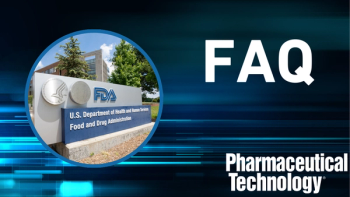
PTSM: Pharmaceutical Technology Sourcing and Management
- PTSM: Pharmaceutical Technology Sourcing and Management-08-01-2007
- Volume 3
- Issue 8
Regulatory and association news
The latest on active pharmaceutical ingredients in development and under commercial manufacture
Developments from the US Food and Drug Administration, European Medicines Agency, and other key regulatory bodies and news from key trade associations.
Rockville, MD (July 25)—The
The report addresses regulatory and scientific issues. The report outlines that nanoscale materials potentially could be used in most product types regulated by FDA and that those materials present challenges similar to those posed by products using other emerging technologies. The challenges, however, may be complicated by the fact that properties relevant to product safety and effectiveness may change as size varies within the nanoscale.
The report recommends consideration of agency guidance that would clarify, for example, what information to give FDA about products, and also when the use of nanoscale materials may change the regulatory status of particular products. As with other FDA guidance, draft guidance documents would be made available for public comment before being finalized.
The report may be found
Rockville, MD (July 20)—The
The draft guidance on cooperative manufacturing arrangements applies to biological products subject to licensure under section 351 of the Public Health Service Act (PHS Act) (42 USC 262). This document is issued jointly by the Center for Biologics Evaluation and Research and the Center for Drug Evaluation and Research.
The draft guidance addresses several types of manufacturing arrangements (i.e., short-supply arrangements, divided-manufacturing arrangements, shared-manufacturing arrangements, and contract-manufacturing arrangements) and describes certain reporting and recordkeeping responsibilities associated with these arrangements for the licensed manufacturer(s), contract manufacturer(s), and final product manufacturer(s). These responsibilities include: notification of any proposed change in the product, production process, quality controls or facilities; notification of results of tests and investigations related to or impacting the product; notification of products manufactured in a contract facility; and standard operating procedures.
Comments on the draft guidance are due Sept. 1, 2007. The draft guidance may be found
Rockville, MD (July 13)—The
The ICH Q10 draft guideline describes one approach for "an effective pharmaceutical quality system that is based on ISO concepts, includes applicable good manufacturing practice regulations and complements ICH Q8 'Pharmaceutical Development' and Q9 'Quality Risk Management.'" The guideline, which is optional, applies to pharmaceutical drug substances and drug products, including biotechnology and biological products, throughout the product life cycle.
The document specifically outlines the "product life cycle" to include pharmaceutical development, technology transfer, manufacturing, and product discontinuation. Among the areas discussed in the guideline are management responsibility (including planning, management, communication, and review), continual improvement of process performance and product quality (including life cycle stage goals), and continual improvement of the pharmaceutical quality system (including monitoring internal and external impact factors).
The
Rockville, MD (July 9)—A new guidance issued by the
Articles in this issue
over 18 years ago
A Mid-Year Scorecard for Big Pharmaover 18 years ago
Vetter Pharma Invests in Sterile Manufacturingover 18 years ago
Expansionsover 18 years ago
Agreements and pactsover 18 years ago
Mergers, acquisitions, and restructuringover 18 years ago
Improving Routes in API Manufacturingover 18 years ago
PeopleNewsletter
Get the essential updates shaping the future of pharma manufacturing and compliance—subscribe today to Pharmaceutical Technology and never miss a breakthrough.





